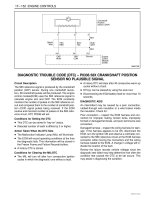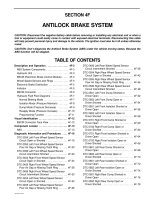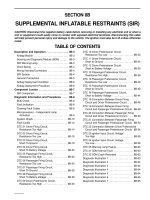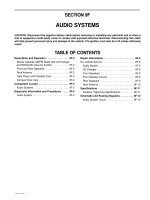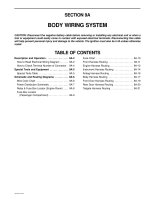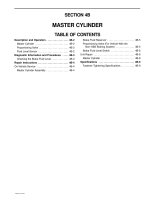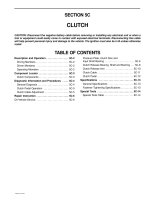hệ thống điều khiển động cơ trang 55-151 trên xe matiz đời 2000 - 2013
Bạn đang xem bản rút gọn của tài liệu. Xem và tải ngay bản đầy đủ của tài liệu tại đây (480.55 KB, 97 trang )
ENGINE CONTROLS 1F–55
DAEWOO M-150 BL2
DIAGNOSTIC TROUBLE CODE DIAGNOSIS
CLEARING TROUBLE CODES
Notice: To prevent Engine Control Module (ECM) dam-
age, the key must be OFF when disconnecting or recon-
necting the power to the ECM (for example battery
cable, ECM pigtail connector, ECM fuse, jumper cables,
etc.).When the ECM sets a Diagnostic Trouble Code
(DTC), the Malfunction Indicator Lamp (MIL) lamp will
be turned on only for type A, B and E but a DTC will be
stored in the ECM’s memory for all types of DTC. If the
problem is intermittent, the MIL will go out after 10 sec-
onds if the fault is no longer present. The DTC will stay
in the ECM’s memory until cleared by scan tool. Remov-
ing battery voltage for 10 seconds will clear some stored
DTCs.
DTCs should be cleared after repairs have been com-
pleted. Some diagnostic tables will tell you to clear the
codes before using the chart. This allows the ECM to set
the DTC while going through the chart, which will help to
find the cause of the problem more quickly.
DIAGNOSTIC TROUBLE CODES
DTC Function Error Type Illuminate MIL
P0107 Manifold Absolute Pressure Sensor Low Voltage A YES
P0108 Manifold Absolute Pressure Sensor High voltage A YES
P0112 Intake Air Temperature Sensor Low Voltage E YES
P0113 Intake Air Temperature Sensor High voltage E YES
P0117 Engine Coolant Temperature Sensor Low Voltage A YES
P0118 Engine Coolant Temperature Sensor High voltage A YES
P0122 Throttle Position Sensor Low Voltage A YES
P0123 Throttle Position Sensor Hig voltage A YES
P0131 Oxygen Sensor Low Voltage A YES
P0132 Oxygen Sensor High Voltage A YES
P0133 Oxygen Sensor No Activity E YES
P0137 Heated Oxygen Sensor Low Voltage E YES
P0138 Heated Oxygen Sensor high voltage E YES
P0140 Heated Oxygen Sensor No Activity E YES
P0141 Heated Oxygen Sensor Heater Malfuction E YES
P0171 Fuel Trim System Too Lean E YES
P0172 Fuel Trim System Too Rich E YES
P1230 Fuel Pump Relay Low Voltage A YES
P1231 Fuel Pump Relay High Voltage A YES
P0261 Injector 1 Low Voltage A YES
P0262 Injector 1 high voltage A YES
P0264 Injector 2 Low Voltage A YES
P0265 Injector 2 high voltage A YES
P0267 Injector 3 Low Voltage A YES
P0268 Injector 3 high voltage A YES
P0300 Multifle Cylinder Misfire A/E BLINKING/ON
P1320 Crankshatft Segment Period Segment Adaptation At Limit E YES
P1321 Crankshatft Segment Period Tooth Error E YES
P0327 Knock Sensor Circuit Fault E YES
P0335 Magnetic Crankshaft Position Sensor Electrical Error E YES
1F– 56 ENGINE CONTROLS
DAEWOO M-150 BL2
Diagnostic Trouble Codes (Cont’d)
DTC Function Error Type Illuminate MIL
P0336 58X Crankshaft Position Sensor Extra/missing Pulse E YES
P0337 58X Crankshaft Sensor No Signal E YES
P0341 Camshaft Position Sensor Rationality E YES
P0342 Camshaft Position Sensor No Signal E YES
P0351 Ignition Signal Coil A Fault A YES
P0352 Ignition Signal Coil B Fault A YES
P0353 Ignition Signal Coil C Fault A YES
P1382 Rough Road Data Invalid (Non ABS) Cnl NO
P1382 Rrough Road Data Invalid (ABS) Cnl NO
P1385 Rough Road Sensor Circuit Fault (Non ABS) Cnl NO
P1385 Rough Road Sensor Circuit Fault (ABS) Cnl NO
P0400 Exhaust Gas Recirculation Out of Limit E YES
P1402 Exhaust Gas Recirculation Blocked E YES
P1403 Exhaust Gas Recirculation Valve Failure E YES
P0404 Electric Exhaust Gas Recirculation (EEGR) Opend E YES
P1404 Electric Exhaust Gas Recirculation (EEGR) Closed E YES
P0405 EEGR Pintle Position Sensor Low Voltage E YES
P0406 EEGR Pintle Position Sensor High voltage E YES
P0420 Catalyst Low Efficiency E YES
P0444 EVAP Purge Control Circuit No Signal E YES
P0445 EVAP Purge Control Circuit Fault E YES
P0462 Fuel Level Sensor Low Voltage Cnl NO
P0463 Fuel Level Sensor High voltage Cnl NO
P0480 Low Speed Cooling Fan Relay Circuit Fault (Without A/C) Cnl NO
P0480 Low Speed Cooling Fan Relay Circuit Fault (With A/C) Cnl NO
P0481 High Speed Cooling Fan Relay High Voltage (Without A/C) Cnl NO
P0481 High Speed Cooling Fan Relay High Voltage (With A/C) Cnl NO
P0501 Vehicle Speed No Signal (M/T Only) A YES
P0505 Idle Air Control Valve (IACV) Error E YES
P1535 Evaporator Temperature Sensor High Voltage Cnl NO
P1536 Evaporator Temperature Sensor Low Voltage Cnl NO
P1537 A/C Compressor Relay High Voltage Cnl NO
P1538 A/C Compressor Relay Low Voltage Cnl NO
P0562 System Voltage (Engine Side) Too Low Cnl NO
P0563 System Voltage (Engine Side) Too High Cnl NO
P0601 Engine Control Module Checksum Error E YES
P0604 Engine Control Module RAM Error E YES
P0605 Engine Control Module NMVY Write Error E YES
P1610 Main Relay High Voltage A YES
P1611 Main Relay Low Voltage A YES
P1628 Immobilizer No Successful Communication Cnl NO
P1629 Immobilizer Wrong Computation Cnl NO
P0656 Fuel Level Gauge High Circuit Fault Cnl NO
ENGINE CONTROLS 1F–57
DAEWOO M-150 BL2
Diagnostic Trouble Codes (Cont’d)
DTC Function Error Type Illuminate MIL
P1660 Malfunction Indicator Lamp(MIL) High Voltage E YES
P1661 Malfunction Indicator Lamp(MIL) Low Voltage E YES
1F– 58 ENGINE CONTROLS
DAEWOO M-150 BL2
MAA1F060
DIAGNOSTIC TROUBLE CODE (DTC) – P0107
MANIFOLD ABSOLUTE PRESSURE SENSOR LOW VOLTAGE
Circuit Description
The engine control module (ECM) uses the Manifold Ab-
solute Pressure (MAP) sensor to control the fuel deliv-
ery and the ignition timing. The MAP sensor measures
the changes in the intake manifold pressure, which re-
sults from engine load (intake manifold vacuum) and the
rpm changes; and converts these into voltage outputs.
The ECM sends a 5 volt-reference voltage to the MAP
sensor. As the manifold pressure changes, the output
voltage of the MAP sensor also changes. By monitoring
the MAP sensor output voltage, the ECM knows the
manifold pressure. A low-pressure (low voltage) output
voltage will be about 1.0 to 1.5 volts at idle, while higher
pressure (high voltage) output voltage will be about 4.5
to 5.0 at wide open throttle (WOT). The MAP sensor is
metric pressure, allowing the ECM to make adjustments
for different altitudes.
Conditions for Setting the DTC
D This DTC can be stored in “key-on” status.
(Case A)
D When the engine idling.
D No throttle position(TP) sensor fail conditions pres-
ent.
D Engine speed(rpm) is less than 2,500rpm.
D The MAP is less than 15kPA.
(Case A)
D When the engine part load.
D The engine revolution speed is less than 4,000rpm.
D No Throttle Position (TP) Sensor fails conditions
present.
D The Throttle Position (TP) angle greather than 20.0
D The MAP is less than 15 kPA.
An open or low voltage condition exists.
Action Taken when the DTC Sets
D The Malfunction Indicator Lamp (MIL) will illuminate.
D The ECM will record operating conditions at the time
the diagnostic fails. This information will be stored in
the Freeze Frame and Failure Records buffers.
D A history DTC is stored.
D The coolant fan turns ON.
D The ECM will substitutes a fixed MAP value and use
TP to control the fuel delivery (the scan tool will not
show defaulted)
Conditions for Clearing the MIL/DTC
D The MIL will turn off after four consecutive ignition
cycles in which the diagnostic runs without a fault.
D A history DTC will clear after 40 consecutive warm-up
cycles without a fault.
D DTC(s) can be cleared by using the scan tool.
Diagnostic Aids
With the ignition ON and the engine stopped, the man-
ifold pressure is equal to atmosphere pressure and the
signal voltage will be high.
The ECM as an indication of vehicle altitude uses this
information. Comparison of this reading with a known
good vehicle with the same sensor is a good way to
check the accuracy of a suspect sensor. Readings
should be the same ±0.4volt.
If a DTC P 0107 is intermittent, refer to “Manifold Abso-
lute Pressure Check” in this Section for further diagno-
sis.
ENGINE CONTROLS 1F–59
DAEWOO M-150 BL2
If the connections are OK monitor the manifold absolute
pressure (MAP) sensor signal voltage while moving re-
lated connectors and the wiring harness. If the failure is
induced, the display on the scan tool will change. This
may help to isolate the location of an intermittent mal-
function.
DTC P0107 – Manifold Absolute Pressure Sensor Low Voltage
Step Action Value(s) Yes No
1
Perform an Euro On-Board Diagnostic (EOBD)
System Check.
Is the system check complete?
–
Go to Step 2
Go to
“On-Board
Diagnostic
System Check”
2
1. Connect the scan tool to the data link connector
(DLC).
2. Turn the ignition switch to ON.
Does the scan tool show the manifold absolute
pressure (MAP) sensor voltage above the value
specified? 4V Go to Step 3 Go to Step 4
3
1. Disconnect the vacuum line from the MAP
sensor.
2. Apply 88kPA (20in.of Hg) of vacuum to the MAP
sensor.
Does the scan tool show the MAP sensor voltage
within the value specified? 1.0–1.5V
Go to
“Diagnostic
Aids” Go to Step 4
4
1. Turn the ignition switch to LOCK.
2. Disconnect the MAP sensor connector.
3. Turn the ignition switch to ON.
4. Measure the voltage between the MAP sensor
connector terminals A and C.
Does the voltage measure within the value
specified? 4.5–5.0V Go to Step 5 Go to Step 6
5
Connect a fused jumper between the MAP sensor
connector terminals B and C.
Does the scan tool show the MAP sensor voltage
above the value specified? 4V Go to Step 11 Go to Step 9
6
Measure the voltage between the MAP sensor
connector terminal A and ground.
Does the voltage measure within the value
specified? 4.5–5.0V Go to Step 7 Go to Step 8
7
1. Turn the ignition switch to LOCK.
2. Check for open wires between the MAP sensor
connector terminal A and the ECM connector
terminal 78.
Is the problem found?
–
Go to Step 10 Go to Step 12
8
1. Turn the ignition switch to LOCK.
2. Check for an open or short to ground in the wire
between the MAP sensor connector terminal C
and the ECM connector terminal 12.
Is the problem found ?
–
Go to Step 10 Go to Step 12
9
1. Turn the ignition switch to LOCK.
2. Check for an open or short to ground in the wire
between the MAP sensor connector terminal B
and the ECM connector terminal 73.
Is the problem found ?
–
Go to Step 10 Go to Step 12
1F– 60 ENGINE CONTROLS
DAEWOO M-150 BL2
DTC P0107 – Manifold Absolute Pressure Sensor Low Voltage (Cont’d)
Step Action Value(s) Yes No
10
1. Repair the wire or the connector terminal as
needed.
2. Clear any DTCs from the ECM.
3. Perform the diagnostic system check.
Is the repair complete?
–
System OK
–
11
1. Replace the manifold absolute pressure sensor.
2. Clear any DTCs from the ECM.
3. Perform the diagnostic system check.
Is the replacement complete?
–
System OK
–
12
Replace the ECM.
Is the replacement complete?
–
Go to Step 13 Go to Step 2
13
Check if any additional DTCs are set.
Are any DTCs displaced that have not been
diagnosed?
–
Go to
applicable DTC
table
System OK
ENGINE CONTROLS 1F–61
DAEWOO M-150 BL2
BLANK
1F– 62 ENGINE CONTROLS
DAEWOO M-150 BL2
MAA1F060
DIAGNOSTIC TROUBLE CODE (DTC) – P0108 MANIFOLD ABSOLUTE
PRESSURE SENSOR HIGH VOLTAGE
Circuit Description
The engine control module (ECM) uses the Manifold Ab-
solute Pressure (MAP) sensor to control the fuel deliv-
ery and the ignition timing. The MAP sensor measures
the changes in the intake manifold pressure, which re-
sults from engine load (intake manifold vacuum) and the
rpm changes; and converts these into voltage outputs.
The ECM sends a 5 volt-reference voltage to the MAP
sensor. As the manifold pressure changes, the output
voltage of the MAP sensor also changes. By monitoring
the MAP sensor output voltage, the ECM knows the
manifold pressure. A low-pressure (low voltage) output
voltage will be about 1.0 to 1.5 volts at idle, while higher
pressure (high voltage) output voltage will be about 4.5
to 4.8 at wide open throttle (WOT). The MAP sensor is
metric pressure, allowing the ECM to make adjustments
for different altitudes.
Conditions for Setting the DTC
D This DTC can be stored in “key-on” status.
D Engine speed is greater than 2,000rpm.
D No throttle position sensor (TPS) fail conditions pres-
ent.
D The MAP is greater than 600m bar.
D A high voltage condition exists.
Action Taken when the DTC Sets
D The Malfunction Indicator Lamp (MIL) will illuminate.
D The ECM will record operating conditions at the time
the diagnostic fails. This information will be stored in
the Freeze Frame and Failure Records buffers.
D A history DTC is stored.
D The ECM will substitutes a fixed MAP value and use
TP to control the fuel delivery (the scan tool will not
show defaulted)
Conditions for Clearing the MIL/DTC
D The MIL will turn off after four consecutive ignition
cycles in which the diagnostic runs without a fault.
D A history DTC will clear after 40 consecutive warm-up
cycles without a fault.
D DTC(s) can be cleared by using the scan tool.
Diagnostic Aids
With the ignition ON and the engine stopped, the man-
ifold pressure is equal to atmosphere pressure and the
signal voltage will be high.
The ECM as an indication of vehicle altitude uses this
information. Comparison of this reading with a known
good vehicle with the same sensor is a good way to
check the accuracy of a suspect sensor. Readings
should be the same ±0.4volt.
If a DTC P 0108 is intermittent, refer to “manifold abso-
lute pressure check” in this Section for further diagnosis.
If the connections are OK monitor the manifold absolute
pressure(MAP) sensor signal voltage while moving re-
lated connectors and the wiring harness. If the failure is
induced, the display on the scan tool will change. This
may help to isolate the location of an intermittent mal-
function.
ENGINE CONTROLS 1F–63
DAEWOO M-150 BL2
DTC P0108 – Manifold Absolute Pressure Sensor High Voltage
Step Action Value(s) Yes No
1
Perform an Euro On-Board Diagnostic (EOBD)
System Check.
Is the system check complete?
–
Go to Step 2
Go to
“On-Board
Diagnostic
System Check”
2
1. Connect the scan tool to the data link connector
(DLC).
2. Turn the ignition switch to ON.
Does the scan tool show the manifold absolute
pressure (MAP) sensor voltage above the value
specified? 4V Go to Step 3 Go to Step 4
3
1. Disconnect the vacuum line from the MAP
sensor.
2. Apply 66kPA (20in.of Hg) of vacuum to the MAP
sensor.
Does the scan tool show the MAP sensor voltage
within the value specified? 1.0–1.5V
Go to
“Diagnostic
Aids” Go to Step 4
4
1. Turn the ignition switch to LOCK.
2. Disconnect the MAP sensor connector.
3. Turn the ignition switch to ON.
4. Measure the voltage between the MAP sensor
connector terminals A and C.
Does the voltage measure within the value
specified? 4.5–5.0V Go to Step 5 Go to Step 6
5
Connect a fused jumper between the MAP sensor
connector terminals B and C.
Does the scan tool show the MAP sensor voltage
above the value specified? 4V Go to Step 11 Go to Step 9
6
Measure the voltage between the MAP sensor
connector terminal A and ground.
Does the voltage measure within the value
specified? 4.5–5.0V Go to Step 7 Go to Step 8
7
1. Turn the ignition switch to LOCK.
2. Check for open wires between the MAP sensor
connector terminal A and the ECM connector
terminal 78.
Is the problem found?
–
Go to Step 10 Go to Step 12
8
1. Turn the ignition switch to LOCK.
2. Check for an open or short to ground in the wire
between the MAP sensor connector terminal C
and the ECM connector terminal 12.
Is the problem found ?
–
Go to Step 10 Go to Step 12
9
1. Turn the ignition switch to LOCK.
2. Check for an open or short to ground in the wire
between the MAP sensor connector terminal B
and the ECM connector terminal 73.
Is the problem found ?
–
Go to Step 10 Go to Step 12
10
1. Repair the wire or the connector terminal as
needed.
2. Clear any DTCs from the ECM.
3. Perform the diagnostic system check.
Is the repair complete?
–
System OK
–
1F– 64 ENGINE CONTROLS
DAEWOO M-150 BL2
DTC P0108 – Manifold Absolute Pressure Sensor High Voltage (Cont’d)
Step Action Value(s) Yes No
11
1. Replace the manifold absolute pressure sensor.
2. Clear any DTCs from the ECM.
3. Perform the diagnostic system check.
Is the replacement complete?
–
System OK
–
12
Replace the ECM.
Is the replacement complete?
–
Go to Step 13 Go to Step 2
13
Check if any additional DTCs are set.
Are any DTCs displaced that have not been
diagnosed?
–
Go to
applicable DTC
table
System OK
ENGINE CONTROLS 1F–65
DAEWOO M-150 BL2
BLANK
1F– 66 ENGINE CONTROLS
DAEWOO M-150 BL2
MAA1F100
DIAGNOSTIC TROUBLE CODE (DTC) – P0112 INTAKE AIR TEMPERATURE
SENSOR LOW VOLTAGE
Circuit Description
The Intake Air Temperature (IAT) Sensor uses a therm-
istor to control the signal voltage to the engine control
module (ECM). The ECM supplies a 5 volt reference
voltage and a ground to the sensor. When the air is cold,
the resistance is high ; therefore IAT sensor signal volt-
age will be high. If the intake air is warm, resistance is
low ; therefore the IAT sensor signal voltage will be low.
Conditions for Setting the DTC
D The engine rum time is greater than 3 seconds.
D IAT voltage is less than 0.01V
Action Taken when the DTC Sets
D Emission related.
D “Armed” after two trip with a fail.
D “Disarmed” after one trip with a pass.
D MIL on if failure is detected in three consecutive trips.
D Stores a History DTC on the third consecutive with a
fail (The DTC will be armed after the second fail).
D Stores a Freeze Frame on the third consecutive trip
with a fail (if empty).
D The ECM will default to 60°C(140°F)for intake air
temperature. The scan tool will not show the de-
faulted value.
Conditions for Clearing the MIL/DTC
D The MIL will turn off after four consecutive ignition
cycles in which the diagnostic runs without a fault.
D A history DTC will clear after 40 consecutive warm up
cycles without a fault.
D DTC(s) can be cleared by using the scan tool.
Diagnostic aids
If the vehicle is at ambient temperature, compare the
IAT sensor to the engine coolant temperature(ECT) sen-
sor. The IAT sensor and the ECT sensor should be rela-
tively close to each other. Use the temperature vs.
Resistance Values table to evaluate the possibility of a
skewed sensor. Refer to “Temperature vs. Resistance”
in this Section.
ENGINE CONTROLS 1F–67
DAEWOO M-150 BL2
DTC P0112 – Intake Air Temperature Sensor Low Voltage
Step Action Value(s) Yes No
1
Perform an Euro On-Board Diagnostic (EOBD)
System Check.
Is the system check complete?
–
Go to Step 2
Go to
“On-Board
Diagnostic
System Check”
2
1. Connect the scan tool to the data link
connector(DLC).
2. Run the engine until it reaches operating
temperature.
Does the scan tool show the IAT sensor reading
within the value specified? 15–80°C
Go to
“Diagnostic
Aids” Go to Step 3
3
1. Turn the ignition switch to LOCK.
2. Disconnect the IAT sensor connector.
3. Turn the ignition switch to ON.
Does the scan tool show the IAT sensor reading
within the value specified? ≤ -30°C Go to Step 4 Go to Step 5
4
Check for a faulty connector or terminals at the IAT
sensor connector.
Is the problem found?
–
Go to Step 7 Go to Step 6
5
Check for wire for a short to ground between the IAT
connector terminal 1 and the ECM connector
terminal 79.
Is the problem found?
–
Go to Step 7 Go to Step 6
6
Check for wire for a short to ECM reference voltage
between the IAT sensor connector terminal 2 and
the ECM connector terminal 47.
Is the problem found? 4.5–5.0V Go to Step 7 Go to Step 9
7
1. Turn the ignition switch to LOCK.
2. Repair the wire or the connector terminal as
needed.
3. Clear any DTCs from the ECM.
4. Run the engine until it reaches operating
temperature.
5. Perform the diagnostic system check.
Is the repair complete?
–
System OK
–
8
1. Turn the ignition switch to LOCK.
2. Replace the IAT sensor.
3. Clear any DTCs from the ECM.
4. Run the engine until it reaches operating
temperature.
5. Perform the diagnostic system check.
Is the repair complete?
–
System OK
–
9
1. Turn the ignition switch to LOCK.
2. Replace the engine control module(ECM).
3. Run the engine until it reaches operating
temperature.
4. Perform the diagnostic system check.
Is the repair complete?
–
Go to Step 10
–
10
Check if any additional DTCs are set.
Are any DTCs displaced that have not been
diagnosed?
–
Go to
applicable DTC
table
System OK
1F– 68 ENGINE CONTROLS
DAEWOO M-150 BL2
MAA1F100
DIAGNOSTIC TROUBLE CODE (DTC) – P0113 INTAKE AIR TEMPERATURE
SENSOR HIGH VOLTAGE
Circuit Description
The Intake Air Temperature (IAT) Sensor uses a therm-
istor to control the signal voltage to the engine control
module (ECM). The ECM supplies a 5 volt reference
voltage and a ground to the sensor . when the air is cold,
the resistance is high ; therefore IAT sensor signal volt-
age will be high. If the intake air is warm, resistance is
low ; therefore the IAT sensor signal voltage will be low.
Conditions for Setting the DTC
D The engine rum time is greater than 3 seconds.
D IAT voltage is greater than 4.99V.
Action Taken when the DTC Sets
D Emission related.
D “Armed” after two trip with a fail.
D “Disarmed” after one trip with a pass.
D MIL on if failure is detected in three consecutive trips.
D Stores a History DTC on the third consecutive with a
fail (The DTC will be armed after the second fail).
D Stores a Freeze Frame on the third consecutive trip
with a fail (if empty).
D The ECM will default to last valid value for intake air
temperature. The scan tool will not show the de-
faulted value.
Conditions for Clearing the MIL/DTC
D The MIL will turn off after four consecutive ignition
cycles in which the diagnostic runs without a fault.
D A history DTC will clear after 40 consecutive warm up
cycles without a fault.
D DTC(s) can be cleared by using the scan tool.
Diagnostic Aids
If the vehicle is at ambient temperature, compare the
IAT sensor to the engine coolant temperature (ECT)
sensor. The IAT sensor and the ECT sensor should be
relatively close to each other.
Use the temperature vs. Resistance Values table to
evaluate the possibility of a skewed sensor. Refer to
“Temperature vs. Resistance” in this Section.
ENGINE CONTROLS 1F–69
DAEWOO M-150 BL2
DTC P0113 – Intake Air Temperature Sensor High Voltage
Step Action Value(s) Yes No
1
Perform an Euro On-Board Diagnostic (EOBD)
System Check.
Is the system check complete?
–
Go to Step 2
Go to
“On-Board
Diagnostic
System Check”
2
1. Connect the scan tool to the data link connector
(DLC).
2. Run the engine unit it reaches operating
temperature.
Does the scan tool show the intake air temperature
(IAT) sensor reading within the value specified?
15~80°C
(10~176°F)
Go to
“Diagnostic
Aids” Go to Step 3
3
1. Turn the ignition switch to LOCK.
2. Disconnect the IAT sensor connector.
3. Jumper to IAT sensor connector terminals.
4. Turn the ignition switch to ON.
Does the scan tool show the IAT sensor reading the
value specified?
180°C
(356°F) Go to Step 4 Go to Step 5
4
Check for a faulty connector or terminals 1 and 2 of
the IAT sensor connector.
Is the problem found?
–
Go to Step 10 Go to Step 9
5
Measure the voltage between terminals 1 and 2 of
IAT sensor connector.
Does the voltage measure within the value
specified? 4.5~5.5V Go to Step 11 Go to Step 6
6
Measure the voltage between the IAT sensor
connector terminal 2 and the battery
ground(negative) post.
Does the voltage measure within the value
specified? 4.5~5.5V Go to Step 7 Go to Step 8
7
1. Turn the ignition switch to LOCK.
2. Check for an open or short to battery voltage in
the wire between the IAT sensor connector
terminal 2 and the engine control module(ECM)
connector terminal 47.
Is the problem found?
–
Go to Step 10 Go to Step 11
8
1. Turn the ignition switch to LOCK.
2. Check for an open or short to battery voltage in
the wire between the IAT sensor connector
terminal 1 and the ECM connector terminal 79.
Is the problem found?
–
Go to Step 10 Go to Step 11
9
1. Turn the ignition switch to LOCK
2. Replace the IAT sensor.
3. Clear any DTCs from the ECM.
4. Perform the diagnostic system check.
Is the repair complete?
–
System OK
–
10
1. Turn the ignition switch to LOCK.
2.Repair the wire of the connector terminals as
needed.
3. Clear any DTCs from the ECM.
4. Perform the diagnostic system check.
Is the repair complete?
–
System OK
–
1F– 70 ENGINE CONTROLS
DAEWOO M-150 BL2
DTC P0113 – Intake Air Temperature Sensor High Voltage (Cont’d)
Step Action Value(s) Yes No
11
1. Replace the ECM
2. Perform the diagnostic system check.
Is the repair complete?
–
Go to Step 12
–
12
Check if any additional DTCs are set.
Are any DTCs displaced that have not been
diagnosed?
–
Go to applicable
DTC table System OK
ENGINE CONTROLS 1F–71
DAEWOO M-150 BL2
BLANK
1F– 72 ENGINE CONTROLS
DAEWOO M-150 BL2
MAA1F110
DIAGNOSTIC TROUBLE CODE (DTC) – P0117 ENGINE COOLANT
TEMPERATURE SENSOR LOW VOLTAGE
Circuit Description
The Engine Coolant Temperature sensor (ECT) uses a
thermistor to control the signal voltage to the engine
control module (ECM).
The ECM supplies a voltage on the signal circuit to the
sensor. When the engine coolant is cold, the resistance
is high; therefore the ECT signal voltage will be high.
As the engine warms, the sensor resistance becomes
less, and the voltage drops. At normal engine operating
temperature, the voltage will be between 1.5 and 2.0
volts at the ECT signal terminal.
The ECT sensor is used to the following items:
D Fuel delivery.
D Lock Up Clutch (LUC).
D Ignition.
D Evaporator Emission (EVAP) Canister Purge Valve.
D Electric cooling fan.
Conditions for Setting the DTC
D This DTC can be stored in “key-on” status.
D The engine rum time is greater than 3 seconds.
D A low voltage condition exits.
D ECT voltage is less than 0.03V.
Action Taken when the DTC Sets
D The Malfunction Indicator Lamp (MIL) will illuminate.
D The ECM will record operating conditions at the time
the diagnostic fails. This information will be stored in
the Freeze Frame and Failure Records buffers.
D A history DTC is stored.
D The coolant fan turns ON.
D The ECM will default to 20°C(68°F)for the first 60
seconds of the engine run time, and then
92°C(198°F).
D the scan ttol will not show the defaulted value.
Conditions for Clearing the MIL/DTC
D The MIL will turn off after four consecutive ignition
cycles in which the diagnostic runs without a fault.
D A history DTC will clear after 40 consecutive warm-up
cycles without a fault.
D DTC(s) can be cleared by using the scan tool.
Diagnostic Aids
After the engine has started, the ECT should rise steadi-
ly to about 90°C(194°F) then stabilize when the thermo-
stat opens.
Use the temperature vs. resistance values table to eval-
uate the possibility of a skewed sensor. Refer to “Tem-
perature vs. Resistance” in this Section.
ENGINE CONTROLS 1F–73
DAEWOO M-150 BL2
DTC P0117 – Engine Coolant Temperature Sensor Low Voltage
Step Action Value(s) Yes No
1
Perform an Euro On-Board Diagnostic (EOBD)
System Check.
Is the system check complete?
–
Go to Step 2
Go to
“On-Board
Diagnostic
System Check”
2
1. Connect the scan tool to the data link connector
(DLC).
2. Run the engine until it reaches operating
temperature.
Does the scan tool show the ECT sensor reading
within the value specified?
80~110°C
(176~230°F)
Go to
“Diagnostic
Aids” Go to Step 3
3
1. Turn the ignition switch to LOCK.
2. Disconnect the ECT sensor connector.
3. Turn the ignition switch to ON.
Does the scan tool show the IAT sensor reading
within the value specified? ≥-30°C(-22°F) Go to Step 4 Go to Step 6
4
1. Jumper the ECT sensor signal circuits at terminal
A and B.
2. Turn the ignition switch to ON.
Does the scan tool show the ECT sensor reading
within the value specified?
≥ 120°C Go to Step 5 Go to Step 6
5
1. Replace the ECT sensor.
2. Clear any DTCs from the ECM.
3. Perform the diagnostic system check.
Is the replacement complete?
–
System OK
–
6
Measure the voltage between ECT terminal A and
ground.
Does the voltage measure within the value
specified? 4.5–5.0V Go to Step 7 Go to Step 8
7
1. Turn the ignition switch to LOCK.
2. Disconnect the ECM wiring connector.
3. Check for a faulty connector or terminals at the
ECT sensor connectors and ECM connectors for
short to ECM reference voltage.
Is the problem found?
–
Go to Step 9 Go to Step 8
8
1. Turn the ignition switch to LOCK.
2. Repair the wire of the connector terminals as
needed.
3. Clear any DTCs from the ECM.
4. Run the engine until it reaches operating
temperature.
5. Perform the diagnostic system check.
Is the repair complete?
–
System OK
–
9
1. Replace the ECM.
2. Run the engine until it reaches operating
temperature.
3. Perform the diagnostic system check.
Is the repair complete?
–
Go to Step 10
–
10
Check if any additional DTCs are set.
Are any DTCs displaced that have not been
diagnosed?
–
Go to
applicable DTC
table
System OK
1F– 74 ENGINE CONTROLS
DAEWOO M-150 BL2
MAA1F110
DIAGNOSTIC TROUBLE CODE (DTC) – P0118 ENGINE COOLANT
TEMPERATURE SENSOR HIGH VOLTAGE
Circuit Description
The coolant temperature sensor (ECT) uses a thermis-
tor to control the signal voltage to the engine control
module (ECM).
The ECM supplies a voltage on the signal circuit to the
sensor. When the air is cold, the resistance is high;
therefore the ECT sensor signal voltage will be high.
As the engine warms, the sensor resistance becomes
less, and the voltage drops. At normal engine operating
temperature, the voltage will be between 1.5 and 2.0
volts at the ECT sensor signal terminal.
The ECT sensor is used to the following items:
D Fuel delivery.
D Lock Up Clutch (LUC).
D Ignition.
D Evaporator Emission (EVAP) Canister Purge Valve.
D Idle Air Control (IAC) valve.
D Electric cooling fan.
Conditions for Setting the DTC
D This DTC can be stored in “key-on” status.
D The engine rum time is greater than 3 seconds.
D The ECT sensor indicates that the engine coolant
temperature is less than –40°C(–40°F).
D ECT voltage is greater than 4.98V.
D A low voltage condition exits.
Action Taken when the DTC Sets
D The Malfunction Indicator Lamp (MIL) will illuminate.
D The ECM will record operating conditions at the time
the diagnostic fails. This information will be stored in
the Freeze Frame and Failure Records buffers.
D A history DTC is stored.
D The coolant fan turns ON.
D The ECM will substitutes a fixed MAP value and use
TP to control the fuel delivery (the scan tool will not
show defaulted)
Conditions for Clearing the MIL/DTC
D The MIL will turn off after four consecutive ignition
cycles in which the diagnostic runs without a fault.
D A history DTC will clear after 40 consecutive warm-up
cycles without a fault.
D DTC(s) can be cleared by using the scan tool.
Diagnostic Aids
After the engine has started, the ECT should rise steadi-
ly to about 90°C(194°F) then stabilize when the thermo-
stat opens.
Use the temperature vs. resistance values table to eval-
uate the possibility of a skewed sensor. Refer to “Tem-
perature vs. Resistance” in this Section.
ENGINE CONTROLS 1F–75
DAEWOO M-150 BL2
DTC P0118 – Engine Coolant Temperature Sensor High Voltage
Step Action Value(s) Yes No
1
Perform an Euro On-Board Diagnostic (EOBD)
System Check.
Is the system check complete?
–
Go to Step 2
Go to
“On-Board
Diagnostic
System Check”
2
1. Connect the scan tool to the data link connector
(DLC).
2. Run the engine until it reaches operating
temperature.
Does the scan tool show the ECT sensor reading
within the value specified?
80~110°C
(176~230°F)
Go to
“Diagnostic
Aids” Go to Step 3
3
1. Turn the ignition switch to LOCK.
2. Disconnect the ECT sensor connector.
3. Turn the ignition switch to ON.
Does the scan tool show the ECT sensor reading
within the value specified? ≥ -30°C Go to Step 4 Go to Step 6
4
1. Jumper the ECT sensor signal circuits at terminal
B and A.
2. Turn the ignition switch to ON.
Does the scan tool show the ECT sensor reading
within the value specified?
≥180°C
(356°F)
Go to Step 5 Go to Step 6
5
1. Replace the ECT sensor.
2. Clear any DTCs from the ECM.
3. Perform the diagnostic system check.
Is the replacement complete?
–
System OK
–
6
Measure the voltage between ECT terminal B and
ground.
Does the voltage measure within the value
specified? 4.5–5.0V Go to Step 7 Go to Step 8
7
1. Turn the ignition switch to LOCK.
2. Disconnect the ECM wiring connector.
3. Check for a faulty connector or terminals at the
ECT sensor connector terminal A and the ECM
connector terminal 45 for an open or short to
battery voltage.
Is the problem found?
–
Go to Step 8 Go to Step 9
8
1. Turn the ignition switch to LOCK.
2. Repair the wire of the connector terminals as
needed.
3. Clear any DTCs from the ECM.
4. Run the engine until it reaches operating
temperature.
5. Perform the diagnostic system check.
Is the repair complete?
–
System OK
–
9
1. Replace the ECM.
2. Run the engine until it reaches operating
temperature.
3. Perform the diagnostic system check.
Is the repair complete?
–
Go to Step 10
–
10
Check if any additional DTCs are set.
Are any DTCs displaced that have not been
diagnosed?
–
Go to
applicable DTC
table
System OK
1F– 76 ENGINE CONTROLS
DAEWOO M-150 BL2
MAA1F120
DIAGNOSTIC TROUBLE CODE (DTC) P0122
THROTTLE POSITION SENSOR LOW VOLTAGE
Circuit Description
The Engine Control Module (ECM) supplies a 5 volt ref-
erence voltage signal and a ground to the Throttle Posi-
tion (TP) sensor. The TP sensor sends a voltage signal
back to the ECM relative to the throttle plate opening.
The voltage signal will vary from approximately 0.33
volts at closed throttle, to over 4.3 volts at Wide Open
Throttle (WOT).
The TP signal is used by the ECM for fuel control and for
most of the ECM controlled outputs. The TP signal is
one of the most important inputs used by the ECM for
fuel control and most of the ECM controlled outputs.
Conditions for Setting the DTC
D TP sensor voltage indicates a throttle voltage less
than 0.14 volts.
Action Taken When the DTC Sets
D The Malfunction Indicator Lamp (MIL) will illuminate.
D The ECM will record operating conditions at the time
the diagnostic fails. This information will be stored in
the Freeze Frame and Failure Records buffers.
D A history DTC is stored.
D The TP angle will default to 0% when the vehicle
speed is less than 3 km/h (2 mph) and 10% when the
vehicle speed is greater than 3 km/h (2 mph). The
scan tool will not display the default value.
Conditions for Clearing the MIL/DTC
D The MIL will turn off after four consecutive ignition
cycles in which the diagnostic runs without a fault.
D A history DTC will clear after 40 consecutive warm-up
cycles without a fault.
D DTC(s) can be cleared by using the scan tool.
D Disconnecting the ECM battery feed for more than 10
seconds.
Diagnostic Aids
If the DTC P0122 cannot be duplicated, the information
included in the Freeze Frame data can be useful. Use a
scan tool information data to determine the status of the
DTC. If the dc occurs intermittently, using the Diagnostic
table may help isolate the problem.
ENGINE CONTROLS 1F–77
DAEWOO M-150 BL2
DTC P0122 – Throttle Position Sensor Low Voltage
Step Action Value(s) Yes No
1
Perform an On-Board Diagnostic (EOBD) System
Check.
Was the check performed?
–
Go to Step 2
Go to
“On-Board
Diagnostic
System Check”
2
1. Install a scan tool to the Data Link Connector
(DLC).
2. Turn the ignition ON.
Is the Throttle Position (TP) sensor voltage below
the specified value? 0.20 V Go to Step 4 Go to Step 3
3
1. Turn the ignition ON.
2. Review the Freeze Frame data and note the
parameters.
3. Operate the vehicle within the Freeze Frame
conditions and Conditions for Setting the DTC as
noted.
Is the TP sensor voltage below the specified value? 0.20 V Go to Step 4 Go to Step 12
4
1. Turn the ignition OFF.
2. Disconnect the TP sensor connector.
3. Turn the ignition ON.
4. Jump the 5 volt reference circuit terminal B and
the TP signal circuit terminal C at the TP sensor
connector.
Is the TP sensor voltage over the specified value? 4.0 V Go to Step 10 Go to Step 5
5
Connect a test light between B+ and the TP sensor
signal circuit terminal C.
Is the TP sensor voltage greater than the specified
value? 4.0 V Go to Step 6 Go to Step 8
6
Check the TP sensor 5 volt reference circuit for an
open or short to ground and repair as needed.
Is the repair complete?
–
Go to Step 12 Go to Step 7
7
Check the 5 volt reference circuit for a poor
connection at terminal 75 of the Engine Control
Module (ECM) and repair as needed.
Is the repair complete?
–
Go to Step 12 Go to Step 11
8
Check the TP sensor signal circuit between terminal
C of the TP sensor and terminal 44 of the ECM for
an open or a short to ground and repair as needed.
Is the repair complete?
–
Go to Step 12 Go to Step 9
9
Check the TP sensor signal circuit, terminal 44 of
the ECM for a poor connection and repair as
needed.
Is the repair complete?
–
Go to Step 12 Go to Step 11
10
Replace the throttle body assembly.
Is the action complete?
–
Go to Step 12
–
11
1. Turn the ignition switch OFF.
2. Replace the ECM.
Is the action complete?
–
Go to Step 12
–
1F– 78 ENGINE CONTROLS
DAEWOO M-150 BL2
DTC P0122 – Throttle Position Sensor Low Voltage (Cont’d)
Step Action Value(s) Yes No
12
1. Using the scan tool, clear the Diagnostic Trouble
Codes (DTCs).
2. Start the engine and idle at normal operating
temperature.
3. Operate the vehicle within the Conditions for
setting this DTC as specified in the supporting
text.
Does the scan tool indicate that this diagnostic has
run and passed?
–
Go to Step 13 Go to Step 2
13
Check if any additional DTCs are set.
Are any DTCs displayed that have not been
diagnosed?
–
Go to
Applicable DTC
Table System OK
ENGINE CONTROLS 1F–79
DAEWOO M-150 BL2
BLANK
